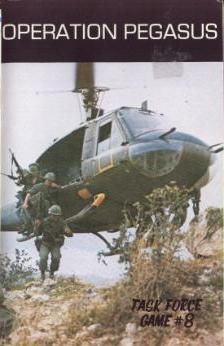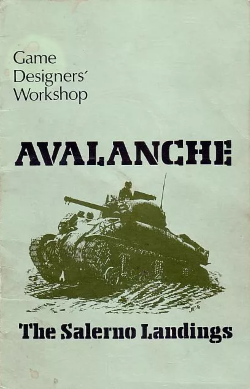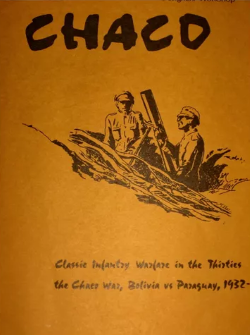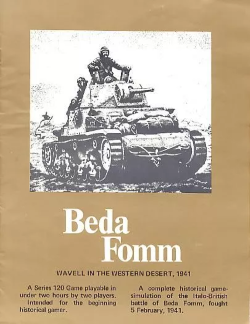
Citadel:The Battle of Dien Bien Phu is a board wargame published by Game Designers Workshop (GDW) in 1977 that is a simulation of the Battle of Dien Bien Phu that marked the end of the First Indochina War in 1954.

Citadel:The Battle of Dien Bien Phu is a board wargame published by Game Designers Workshop (GDW) in 1977 that is a simulation of the Battle of Dien Bien Phu that marked the end of the First Indochina War in 1954.
Citadel is a two-player game in which one player controls the forces of the French Foreign Legion holding the Dien Bien Phu citadel, and the other player controls the Viet Minh besiegers.
The game box (or ziplock bag) contains: [1]
Each turn is 24 hours. [2] The game comes with a series of chronologically linked scenarios that cover each phase of the battle. [3] Although each separate scenario is only 5–7 turns, reviewer Brian Laidlaw noted that each one still takes 12–14 hours to complete. [2] There is a complete Campaign game that covers the entire battle from start to finish in 55 turns. [2]
Movement is unusual for wargames of the time: there is no limit to how far a unit may move except that every third hex, a moving unit may be subject to enemy fire, and the unit must stop if it comes up against an enemy unit's zone of control. [3] Starting with the second scenario, the Viet Minh can entrench towards the French positions, thus avoiding movement in the open. [2]
The French forces start the game with ten tanks, but these cannot be replaced if disabled, although they can be repaired. Likewise, only the French have airplanes, which can be used for artillery spotting, resupply or bombing raids. If the citadel's airstrip is destroyed or taken, then the French lose access to this resource. [2]
The combat system is complex – some reviewers called it "overwrought" [2] — and each separate combat die roll requires several calculations to achieve results. [2]
If the Viet Minh take objectives set out for them while keeping their losses within defined limits, then they win the scenario. Any other result is a French victory. [2]
Citadel was designed by Frank Chadwick, with cover art by Rodger B. MacGowan, and was published by GDW in 1977 as both a ziplock bag edition, and as a boxed set. [1]
In Issue 29 of Phoenix , Brian Laidlaw liked the limitless movement system, which he thought forced the player on the defensive to decide when to fire at an advancing enemy. He agreed that the combat system was complex, but found it "satisfying to use, and the results 'feel' right." He concluded with a strong recommendation, saying, "It's not an easy game and perhaps when all is said and done the subject does not have wide appeal. But it is a game which rewards the thinker and the planner and, more importantly, once you've cracked the mechanics of the thing and got to grips with the action it's very exciting and darn good fun." [2]
In Issue 77 of Campaign, Don Lowry called Citadel, "a very interesting, innovative and challenging tactical modern warfare game [...] That the combat system is innovative definitely follows from the complete lack of movement allowances in the game." [4]
In Issue 33 of Moves , John Prados called the components "impressive". Looking at game strategy, Prados was equally as impressed, noting that for the Viet Minh player, this game "is not completely a matter of 'human wave' tactics. Some sophistication in tactical techniques is available to both players." Prados also found the morale rules that simulated the French increase in morale as their numbers were reduced were "a fine touch from designer Chadwick." He did, however, have some issues with replacement rules, saying that the casualty rate for the Viet Minh in the game is far higher than during the actual battle. Prados also noted historical issues with the number of artillery units for both sides. Prados concluded on a positive note, saying, "The excitement level is high due to the extremely interactive player-turns, and few notice the passage of time that it takes to run through complete game turns [...] Altogether a satisfying game for a francophile who wants to feel caught between Dien Bien Phu and the devil or for a prospective Viet Minh sympathizer who can see the light at the end of the entrenched camp." [3]
In The Guide to Simulations/Games for Education and Training, Martin Campion warned that "This is an intricate and long game, but it is also a fascinating and convincing study of a crucial battle in contemporary history." [5]
At the 1978 Origins Awards, Citadel won two Game Designers Guild Awards: Best Movement System of 1977; and Best Combat System of 1977. [1]

Air Assault on Crete is a wargame published by Avalon Hill in 1977 that simulates the Battle of Crete during World War II.

Operation Castor was a French airborne operation in the First Indochina War. The operation established a fortified airhead in Điện Biên Province, in the north-west corner of Vietnam and was commanded by Brigadier General Jean Gilles. The Operation began at 10:35 on 20 November 1953, with reinforcements dropped over the following two days. With all its objectives achieved, the operation ended on 22 November. Castor was the largest airborne operation since World War II.

Battle for Hue is a board wargame published by Simulations Design Corporation (SDC) in 1973 that simulates the battle for the city of Huế during the 1968 Tet Offensive of the Vietnam War. It was later reissued by Mayfair Games as Hue.

Operation Pegasus is a board wargame published by Task Force Games that simulates the 1968 Battle of Khe Sanh during the Vietnam War.

Avalanche: The Salerno Landings is a board wargame published by Game Designers' Workshop (GDW) in 1976 that simulates the nine-day battle for the beachhead at Salerno in September 1943 following the Allied amphibious landing known as Operation Avalanche.

Team Yankee, subtitled "A Game of World War III", is a board wargame published by Game Designers' Workshop (GDW) in 1987 that is based on the book of the same name by Harold Coyle.

Narvik: The Campaign in Norway, 1940 is a board wargame published by Game Designers' Workshop (GDW) in 1974 that simulates Operation Weserübung, the German invasion of Denmark and Norway during World War II. The game was one of the first in the Europa series of twenty interlocking games envisioned by GDW that would cover the entire European and North African theatres from the start to the end of World War II, using identical map scales and similar rules.

1942 is a board wargame published by Game Designers Workshop (GDW) in 1978 that is a strategic simulation of Japan's invasion of the Philippines, Indonesia, and Indochina in 1942.

White Death, subtitled "Velikiye Luki, The Stalingrad of the North", is a board wargame published by Game Designers Workshop (GDW) in 1979 that is a strategic simulation of the Battle of Velikiye Luki during World War II.

Dieppe, subtitled "An Operational Game of the Allied Raid on Fortress Europe, August 1942", is a board wargame published by Simulations Canada in 1977 that is a simulation of Operation Jubilee, the disastrous Dieppe Raid made by Canadian and British forces during World War II.

Chaco, subtitled "Classical Infantry Warfare in the Thirties", is a board wargame published by Game Designers' Workshop (GDW) in 1973 that simulates the 20th-century Chaco War between Bolivia and Paraguay.

Crimea: The Dawn of Modern Warfare is a board wargame published by Game Designers' Workshop (GDW) in 1975 that simulates the Crimean War.

Coral Sea, subtitled "Turning the Japanese Advance, 1942", is a board wargame published by Game Designers' Workshop (GDW) in 1974 that simulates the Battle of the Coral Sea in the Pacific Theater of World War II.

Battle for Midway: Decision in the Pacific, 1942 is a board wargame published by Game Designers' Workshop (GDW) in 1976 that simulates the Battle of Midway during World War II.

Burma is a board wargame published by Game Designer's Workshop (GDW) in 1976 that simulates the battle between Japan and an alliance of nations for control of Burma during World War II.

Beda Fomm, subtitled "Wavell in the Western Desert, 1941", is a board wargame published by Game Designer's Workshop (GDW) in 1979 that simulates the Battle of Beda Fomm during World War II. The game was part of GDW's "120 System", games that contained 120 counters, and supposedly could be played in 120 minutes.

The Battle of Raphia, 217 B.C. is a board wargame published by Game Designers' Workshop (GDW) in 1977 that simulates the Battle of Raphia during the Syrian Wars. The game was the first in GDW's "Series 120", which featured shorter and less complex games containing only 120 counters that supposedly could be played in 120 minutes.

East Front is a board wargame published by The Control Box, Inc. in 1976 that simulates combat on the Russo-German Front during World War II. The game had unusual hexagonal-shaped counters rather than the more traditional square counters.

Year of the Rat, Vietnam, 1972 is a board wargame published by Simulations Publications Inc. (SPI) in 1972 that simulates the Easter Offensive that had just happened during the Vietnam War.

Dien Bien Phu, subtitled "Strategic Game of Indochina 1950-55" is a board wargame published by Simulations Design Corporation (SDC) in 1973 that simulates the final five years of the First Indochina War in the northern French protectorate of Tonkin.